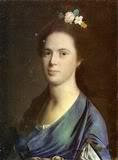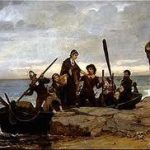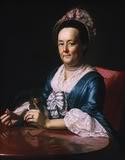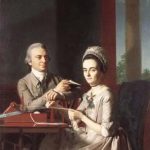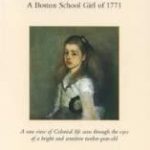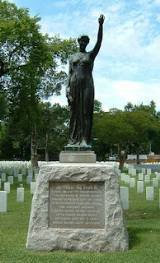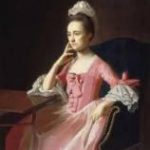Wife of American Portrait Artist John Singleton Copley
Susannah Farnham Clarke was born on May 20, 1745, in Boston, Massachusetts, the daughter of Richard Clarke and Elizabeth Winslow, both of whom were of high social position. Richard had graduated from Harvard College in 1729, and became one of the most prominent merchants in Boston, later under the name of Richard Clarke & Sons. Elizabeth Winslow’s ancestry goes back to Mary Chilton, who came from England on the Mayflower in 1620.
John Singleton Copley was born July 26, 1738, son of humble Irish parents, Richard and Mary Singleton Copley, recent Irish immigrants, who lived in a very simple home and ran a tobacco shop on Long Wharf in Boston. Long Wharf was home to approximately 40% of colonial American shipping, and a center of trade, with exports such as lumber, beef, and furs, and imports such as textiles, glass, sugar, and rum.
Copley’s father died when he was a young boy, but his mother had married an English artist named Peter Pelham in 1748, and they moved to his new home on Lindel’s Row, a quieter and more respectable part of Boston. Though it was only a short distance from Long Wharf, it was socially and economically an upward move, broadening Copley’s exposure to small businessmen.
In Lindel’s Row, Copley was surrounded by skilled laborers, who hawked their wares throughout Boston. Printers, carvers, upholsterers, pottery and fabric designers were among the artisans in his neighborhood. His mother and stepfather were among the small businessmen there, and they sold a variety of goods and services.
Peter Pelham was a London-trained mezzotint engraver and a portrait painter, and he introduced John Copley to portraiture through his European engravings. Though Copley lacked any formal education, Pelham probably instructed the young Copley in drawing, printmaking, and portraiture, as well as introducing him to the English portrait prints that were to influence him throughout his career. Europeans held artists in higher esteem than the early colonists did. To be wealthy in England meant that at some point, a person would have their portrait painted.
Boston was then a small provincial town where art was almost unknown. Early in the 18th century, American colonists had no interest in such luxuries; but by the middle of the century, the cultural divide between the rich and the poor was growing in colonial America. The very wealthy were becoming interested in distinguishing themselves as men and women of breeding, and were becoming more interested in having their portrait painted.
Given the economic and social climate, the conditions were favorable for an artist who could market himself well. Peter Pelham selected well-known subjects as own his clients, thereby gaining notoriety among the elite, and advertised the “truthfulness of the likeness” of his portraits, which appealed to the vanity of colonial aristocrats. He went so far as to offer a financing plan.
Young Copley began at an early age to see visions of lovely forms and faces, which nature impelled him to reproduce with whatever materials as he could find. In 1751, Peter Pelham died, when Copley was only thirteen, but the three years Copley spent with his stepfather proved to be critical to his development as an artist.
John Singleton Copley began painting portraits in his teens in his native Boston. When only 16 years old, he painted and engraved a portrait of the Reverend William Welstead and his success was assured. In the atmosphere of colonial Boston, Copley’s talent was phenomenal. He soon gained local celebrity by painting portraits of the leading families.
In 1758, at the age of twenty, Copley began to develop a style uniquely his own, rather than copying other artists. As his techniques matured, so did his appreciation for colors and fine fabrics, such as the richness of an embroidered silk waistcoat, the smoothness of satin, or delicate lace cuffs. Copley was a prolific producer, and was commissioned by many of the most prominent New England families.
Copley worked in a variety of media throughout his American career. He was the first native-born American artist to paint miniatures and created at least thirty-seven of them between 1755 and the early 1770s. About two-thirds of those known works were painted in oil on copper, and one-third in watercolor on ivory.
John Singleton Copley is considered the greatest U.S. painter of the eighteenth century. He quickly became famous for his portrait paintings of important figures in New England, particularly men and women of the middle class – local merchants and landowners and their wives – in settings and poses flatteringly suggestive of the English aristocracy. He received commissions to paint many of the distinguished Americans of his day, including George Washington.
From about 1760 until 1774, Copley painted the finest portraits of the colonial period. His directness of observation resulted in portraits that conveyed the innate nobility and heroic qualities of the people who pioneered the early American way of life. He was also one of the pioneers of the private exhibition, orchestrating shows and marketing prints of his own work to mass audiences. His portraits were innovative in that they tended to portray their subjects with artifacts that were indicative of their lives.
But Copley had ambitions to be an artist of international standing. Benjamin West, the Pennsylvania painter, wrote to Copley encouraging him to share his work in England, and effectively convinced him his prospects in a colonial town were too limited. In 1765, at the age of 27, Copley sent his portrait, Boy with a Squirrel, to London for the spring exhibition of the Society of the Artists of Great Britain.
This piece depicted Copley’s 16-year-old half-brother, Henry Pelham, seated at a table playing with a pet squirrel. Through Benjamin West’s influence, the painting was exhibited at Somerset House. It met with praise from many, including artists such as Sir Joshua Reynolds, and established Copley’s fame in England.
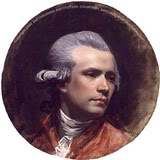
Image: John Singleton Copley
Self Portrait
Copley, in his letters to West of October 13 and November 12, 1766, gleefully accepted an invitation to send more paintings to England and mournfully referred to himself as “peculiarly unlucky in living in a place into which there has not been one portrait brought that is worthy to be called a picture within my memory.” In 1767, on Benjamin West’s nomination, Copley was elected a fellow of the Society of Artists of Great Britain.
In the fall of 1768, British troops landed in Boston and marched to Faneuil Hall, causing great unrest. To calm the citizenry, the king ordered General Thomas Gage to Boston. Initially, Bostonians found him both dignified and affable, and he is so portrayed by Copley. Copley borrowed his design from seventeenth- and eighteenth-century military portraits, showing Gage dominating the foreground and pointing to a miniaturized landscape in which tiny soldiers drill.
Susannah Farnham Clarke married John Singleton Copley November 16, 1769, thereby linking him to one of the most prominent and prosperous merchant families in Boston. They were to have six children over the next several years – Elizabeth, John, Mary, Clarke, Susannah, and Jonathan – three of whom died at young ages. John and Susannah had a long and happy marriage, and afforded him access to a new network of wealthy patrons.
Also in 1769, Copley acquired property at the peak of Beacon Hill, extending down to the Charles River, where he lived virtually next door to one of his sitters, John Hancock, among the richest men in the colonies. There Copley painted the portraits of dignitaries of state and church, graceful women and charming children. As Copley’s commissions grew, he became as wealthy as many of his subjects. Tories and Whigs alike were Copley’s patrons in Boston.
In June 1771, Copley traveled to New York, where he stayed until December. By this time, Copley’s work had reached a level of competence and maturity, which had not been seen before in the works of his contemporaries. His technique became more skilled, and lighting more dramatic. Copley was reaching the zenith of his career in America.
Patriot Portraits
Among Copley’s well-known portraits were of American Patriots John Hancock, Samuel Adams and Paul Revere, the latter being the most famous. These were completed between 1770 and 1772. Paul Revere was a fellow artisan, known from their mutual youth around Lindel’s Row. Copley’s portrait of him is unlike many of his others: Revere is very simply dressed, he is wigless, and he holds a teapot that alludes not only to his craft, but his political viewpoint, becoming an emblem of how increased taxes were strangling the economy in the colonies.
Copley and Paul Revere were colleagues and sometime collaborators. Revere provided gold and silver cases for a number of Copley’s miniatures, and they often served the same patrons. Just as Copley, with his imported silks and leisured manner, represented a way of life soon to end, so the thoughtful, hard-working Revere in a shirt of home-grown cotton, represents the values of the American Revolution.
Though he had married into a distinguished Loyalist family, Copley attempted to remain non-partisan, while still enjoying the social and professional advantages of his new status. Revere, on the other hand, remained firmly identified with his craft, the artisan class from which he came, and his commitment to American liberty.
Copley’s painting of Samuel Adams produced an equally dramatic image that was even more inflammatory. It shows Adams confronting Royal Governor Hutchinson the day after the Boston Massacre. He points to the Massachusetts Royal Charter with his left hand, and holds in his right the petition prepared by his aggrieved fellow citizens that demands the expulsion of British troops from Boston.
Copley’s portrait makes it clear that the Patriot’s volatile character was bound up with the electricity of the moment. Adams stands slightly off center and seems to crowd the table. His face and hands loom out from the dark background, and his ungainly torso and overly large head are presented without flattery, making him seem all the more commanding and his piercing stare all the more intense.
This portrait was commissioned not by Adams but by John Hancock, his sometime partner in political affairs. Hung in Hancock’s house, the site of important revolutionary meetings, it could not fail to persuade. The portrait became well known, and was copied in oils and reproduced in political broadsides. Both stirring and discomforting, the image thus became an instrument of propaganda.
This commission enabled Copley to experiment with a style of portraiture more theatrical than any he had previously attempted. The image depicted a specific historic episode, the urgency of which would have been understood by all who saw it. Far more than any of Copley’s other sitters, Adams is commandingly real, terrifyingly present. His defiant gesture and gaze arrest the viewer. Adams appears to challenge the viewer’s loyalty – a challenge at once inspiring and threatening.
The Clarke Family
Susannah Copley’s family, the Clarkes, had become extremely unpopular with the Patriots. In 1773, her brother, Jonathan Clarke, was in London when her father’s firm, Richard Clarke & Sons, were named agents for the East India Company.
The Townshend Acts of 1767 had basically established the precedent that the British Parliament had the right to tax the colonies, and had placed duties on paper, paint, glass and tea. The colonists had responded by passing a Non-Importation Agreement, whereby colonies agreed not to import English goods. Non-importation was designed to adversely affect English merchants, who would use their influence with the British government to repeal the duties.
From 1766 until 1776, nonimportation was the main weapon employed by the colonists in their unsuccessful attempt to win their demands from the mother country by peaceful means. It had a chilling effect on the British Merchants who traded with the colonies. Non-importation hurt some colonists more than others, and it was therefore difficult to get everyone to observe the agreements.
On November 2, 1773, the Clarkes received a letter ordering them to appear at the Liberty Tree the following Wednesday at noon to make a public resignation of their commission as agents for the East India Company. (The Liberty Tree was a famous elm tree that stood in Boston, near Boston Common, in the days before the American Revolution. The tree was a rallying point for the growing resistance to British rule over the American colonies.)
On Wednesday morning, some of the other consignees, including Tories (British Loyalists) Thomas Hutchinson, Benjamin Faneuil, and Joshua Winslow, met the Clarkes at their warehouse on King Street. A mob of 500 had gathered at the Liberty Tree and, as the merchants did not appear, a considerable number gathered in front of the warehouse. Nine of them went in as emissaries to induce the merchants to yield, and, when they refused to do so, the mob attempted to storm the building but were repulsed.
When Jonathan Clarke arrived home from England, there was a gathering of friends at the Clarkes’ house to welcome him, which led to another attack by the mob. When Isaac Clarke went to Plymouth to collect some debts, he was attacked and forced to make a midnight escape.
Later in November, 1773, vandals attacked the Clarke house and forced the family into hiding. The following month, in the event that came to be known as the Boston Tea Party, 700 casks of Richard Clarke’s tea were dumped into Boston Harbor. The Clarkes were also on the American proscription lists: a roll of Loyalists that publically identified and officially condemned them as enemies of the state.
The Clarke firm at first refused to sign the Non-Importation Agreement, but afterward consented. In May 1774, John Singleton Copley and a hundred others signed a petition opposing the nonimportation agreement and expressing support for Royal Governor Hutchinson.
In April 1774, an unruly mob threatened Copley and his family for allegedly harboring a Tory, Colonel George Watson, whose portrait Copley had painted. The Patriots threatened to have his blood if he “entertained any such Villain for the future.” Copley exclaimed: “What if Mr. Watson had stayed (as I pressed him to) to spend the night. I must either have given up a friend to the insult of a Mob or had my house pulled down and perhaps my family murdered.”
He had strived to maintain the appearance of political neutrality, but he had associated with such radical Patriots as Paul Revere and Samuel Adams, at least long enough to paint them. At the same time, his relationship to the Clarkes made it increasingly difficult to retain the neutral stance that would allow his portrait trade to continue. Copley’s family connections were all Loyalists.
In America, Copley had created at least 273 oil portraits, fifty-eight pastels, thirty-seven miniatures, four history paintings, and one mezzotint between 1753 and 1774. During his later years in Boston, correspondence had continued with his English admirers.
On June 10, 1774, Copley sailed for England without his family, never to return. After a short time in England, he visited Italy and France, spending a year studying the great European masters. From Parma, Italy, Copley wrote to his brother Henry Pelham, urging that the whole family leave America at once since, “if the Frost should be severe and the Harbour frozen, the Town of Boston will be exposed to an attack; and if it should be taken all that have remained in the town will be considered as enemys to the Country and ill treated or exposed to great distress.”
His anxiety was groundless; Susannah and the children had already sailed on May 27, 1775, from Marblehead in a ship crowded with refugees. She arrived in London some weeks before Copley returned from the Continent, and made her home with her brother-in-law, Henry Bromfield. Her father, Richard Clarke, and her brothers came soon after.
Copley arrived in London in October 1775, and was joined there by Susannah and their children, and his father-in-law, Richard Clarke, who lived at John Singleton Copley’s house until his death. With one of his sons, he joined the Loyalist Club of London.
As an English painter, Copley began a promising career in 1775, that seemed destined for great success. His technique was so well established, and the reputation that had preceded him from America was so extraordinary, that he could hardly fail to make a place for himself among British artists. He continued as a portrait painter, but adapted his portrait style to the more painterly British approach. He often said, after his arrival in England, that he could not surpass some of his early works.
He was patronized by the royal family and the nobility, and was elected an associate member, and in 1779 a full member, of the Royal Academy. He also shifted his emphasis from portraiture to multi-figure and historical paintings, and achieved international fame as an artist.
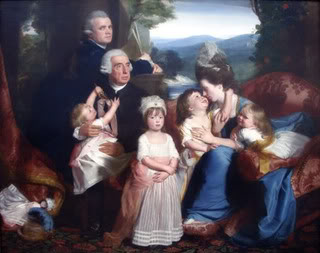
Image: The Copley Family
In I777 at the Royal Academy, he exhibited The Copley Family, which records his delight at being reunited with his family. The artist portrays himself turning away from a sheaf of his sketches to look at the viewer. His wife, Susannah, leans forward to hug their four-year-old son, John Junior. Mary lies on the sofa, while Betsy, the eldest, stands alone in the front, indicative of her seniority. The baby, Susannah, tries to attract her grandfather’s attention with a rattle.
With demand for historical subjects much greater in England than America, Copley pursued this genre seeking new modes of expression, and began to specialize in historical narrative scenes, which are sometimes dismissed by critics as lacking the vibrancy of his earlier portraits. Copley demonstrated a genius, in both his American and British periods, for rendering surface textures and capturing emotional immediacy.
Copley was commissioned to do a very large painting, The Repulse and Defeat of the Spanish Floating Batteries at Gibraltar. These historical paintings were famous for the number of contemporary portraits they contained, and must have entailed an enormous amount of work. He was considered one of the greatest painters of his day, and the commissions he received for this kind of work made him a rich man.
When Copley sent copies of the engraving of his picture, The Death of Chatham, to George Washington and John Adams, the former wrote, “It is rendered more estimable in my eye when I remember that America gave birth to the celebrated artist who produced it.” Adams said, “I shall preserve my copy both as a token of your friendship and as an indubitable proof of American genius.”
Copley would have liked to return to America, but his professional routine prevented it. He painted the Stars and Stripes over a ship in the background of Elkanah Watson’s portrait in December 1782 after listening to King George III’s speech formally acknowledging American independence. His contacts with New England continued as he painted portraits of John Adams, John Quincy Adams and other Bostonians who visited England.
Between 1787 and 1796 Copley exhibited only one picture at the Royal Academy, The Red Cross Knight. But from 1796 to 1812, he faithfully submitted pictures to the academy exhibitions. Bitter disputes between Copley and President Benjamin West about the Royal Academy’s power structure and petty academy rules alienated the former friends.
After 1790, though painting persistently, Copley’s health, productivity, and reputation began to decline. He experienced depression and disappointment. His house in London was expensive to maintain, and his talented son’s education was costly. It grieved the father that after the son began to earn his way, it became necessary to accept his help in supporting the home. An expensive lifestyle and unsuccessful sales of his artwork made borrowing inevitable, and some canvases involving years of labor were left unsold.
Copley’s failing health and eyesight and erratic behavior won him few supporters. In 1810, he had a bad fall which kept him from painting for a month. He resumed paint, however, embarking on notable pictures such as an equestrian portrait of George IV as Prince of Wales.
Often described as bitter and frustrated by financial difficulties and a waning reputation in his later years, he incessantly bewailed the loss of his Boston property. Susannah Copley wrote to her son on December 11, 1810: “Your father has been led to feel this affair [his unsuccessful litigation to recover the farm] more sensibly from the present state of things in this country, where every difficulty of living is increasing and the advantages arising from his profession are decreasing.”
On March 4, 1812, Copley wrote: “I am still pursuing my profession in the hope that, at a future time, a proper amount will be realized from my works, either to myself or family, but at this moment all pursuits which are not among the essentials of life are at a stand.” In August 1813, Susannah wrote that, although her husband was still painting, “he cannot apply himself as closely as he used to do.”
She reported to her son in April 1814: “Your father enjoys his health but grows rather feeble, dislikes more and more to walk; but it is still pleasant for him to go on with his painting.” In June 1815, the Copleys entertained John Quincy Adams, with whom they discussed the new terms of peace between the United States and the United Kingdom. In the letter describing this visit, the painter’s infirmities are said to have been increased by “his cares and disappointments.”
On August 11, 1815, Copley suffered a paralytic stroke during dinner. He seemed at first to recover, and in late August was able to continue painting, but a second shock occurred. “He was perfectly resigned,” wrote his daughter Mary, “and willing to die, and expressed his firm trust in God, through the merits of our Redeemer.”
After a career in both America and England spanning nearly sixty years, John Singleton Copley died peacefully at his home on George Street, Hanover Square, London, on September 9, 1815. He was buried in Highgate Cemetery in a tomb belonging to the Hutchinson family.
How deep into debt Copley had fallen in his latest years was hinted at in Susannah’s letter of February 1, 1816, in which she gave details of his assets and borrowings and predicted: “When the whole property is disposed of and applied toward the discharge of the debts a large deficiency must, it is feared, remain.”
The estate was settled by Copley’s son, later Lord Lyndhurst, who maintained the property on George Street, supported his mother until her death, and kept the ownership of many of the artist’s unsold paintings until March 5, 1864, when they were sold at auction in London. Several of the works then dispersed are now in American collections.
Susannah Farnham Clarke Copley died in 1836.
John Singleton Copley was the greatest and most influential painter in colonial America, producing about 350 works of art. His visual legacy extended throughout the nineteenth century in the work of artists as diverse as Fitz Henry Lane and William Harnett. Boston is justly proud of his associations with that city, and, besides purchasing one of his great pictures, a historical oil painting of Charles I in the House of Commons, by public subscription, it named one of the finest squares in the town Copley Square.
SOURCES
Richard Clarke
Wikipedia: John Singleton Copley
Biography of John Singleton Copley
Painter John Singleton Copley Born
John Singleton Copley Artist Biography
